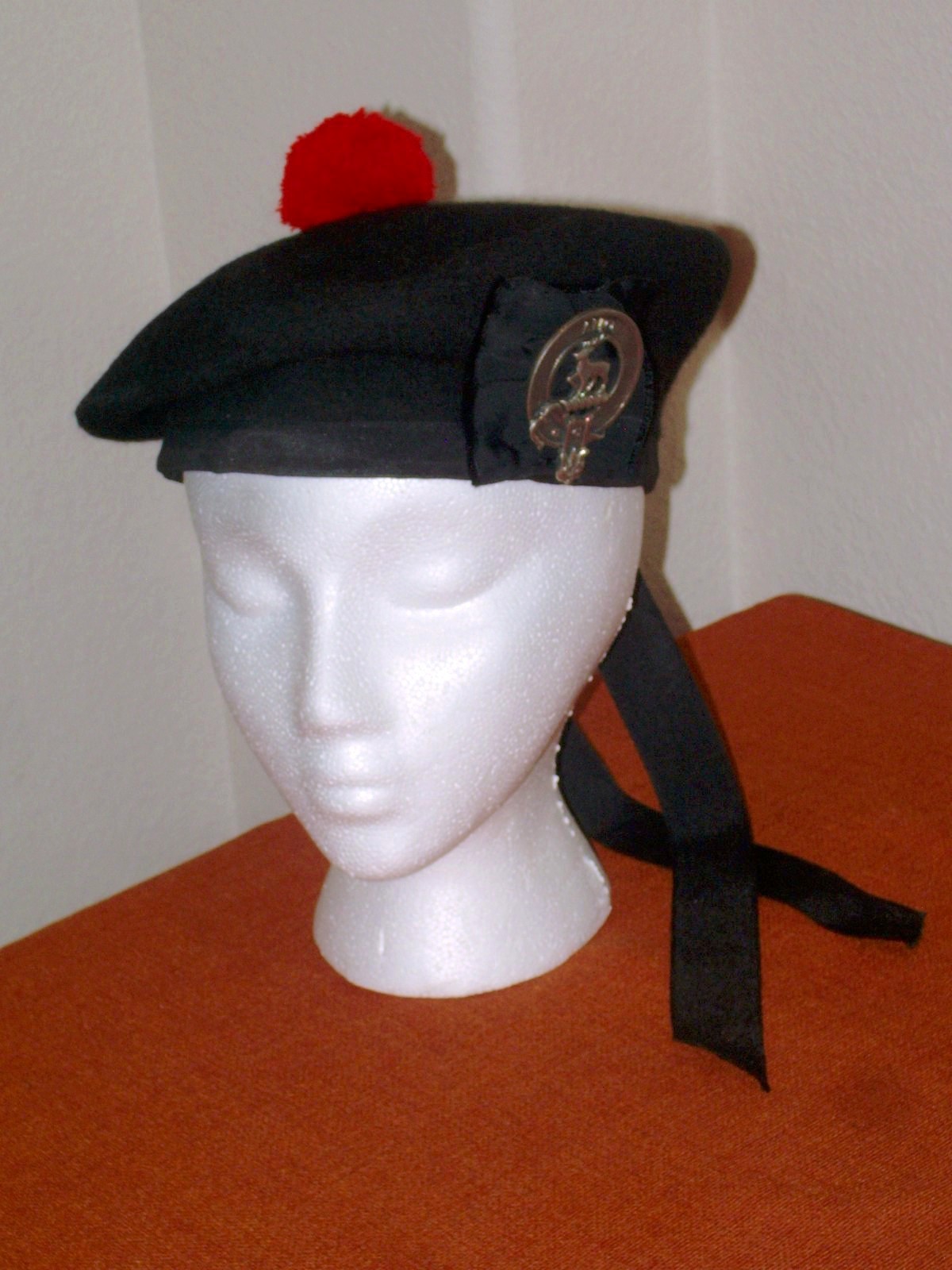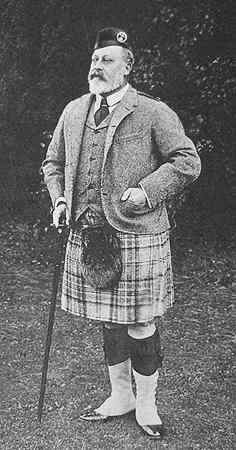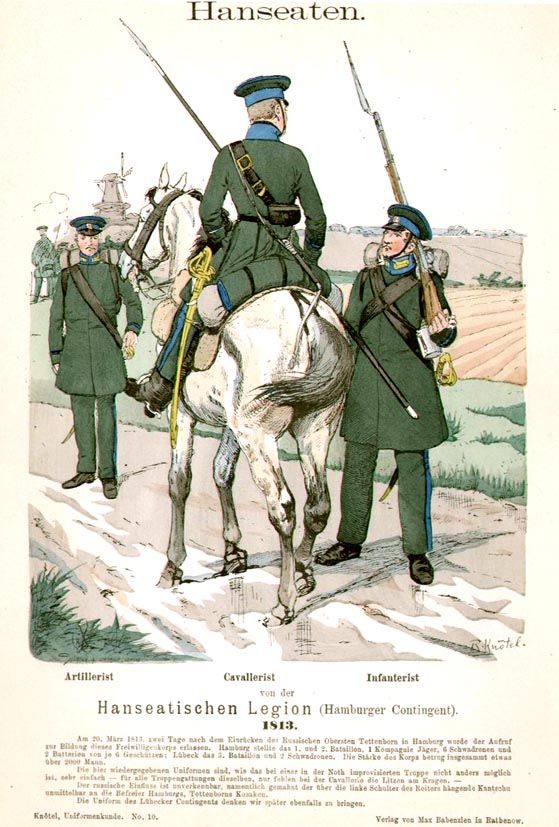|
Glengarry
The Glengarry bonnet is a traditional Scots cap made of thick-milled woollen material, decorated with a toorie on top, frequently a rosette cockade on the left side, and ribbons hanging behind. It is normally worn as part of Scottish military or civilian Highland dress, either formal or informal, as an alternative to the Balmoral bonnet or Tam o' Shanter. History Traditionally, the Glengarry bonnet is said to have first appeared as the head dress of the Glengarry Fencibles when they were formed in 1794 by Alexander Ranaldson MacDonell of Glengarry, of Clan MacDonell of Glengarry. MacDonell, therefore, is sometimes said to have invented the Glengarry – but it is not clear whether early pictures of civilians or Fencible infantry show a true glengarry, capable of being folded flat, or the standard military bonnet of the period merely cocked into a more "fore-and-aft" shape. The first use of the classic, military glengarry may not have been until 1841, when it is said to have be ... [...More Info...] [...Related Items...] OR: [Wikipedia] [Google] [Baidu] |
Clan MacDonell Of Glengarry
Clan MacDonnell of Glengarry ( gd, Clann Dòmhnaill Ghlinne Garaidh) is a Scottish clan and is a branch of the larger Clan Donald.Way, George and Squire, Romily. ''Collins Scottish Clan & Family Encyclopedia''. (Foreword by The Rt Hon. The Earl of Elgin KT, Convenor, The Standing Council of Scottish Chiefs). Published in 1994. Pages 214 – 215. The clan takes its name from Glen Garry where the river Garry runs eastwards through Loch Garry to join the Great Glen about 16 miles (25 km) north of Fort William, Highland. History Origins of the clan Glengarry is in Lochaber which was part of the ancient Kingdom of Moray that was ruled by the Picts. Ranald was the son of John of Islay, Lord of the Isles, and Ranald himself had five sons. One of them was Alan, the progenitor of the Clan Macdonald of Clanranald and another was Donald. Donald married twice: firstly Laleve, daughter of the chief of Clan MacIver, by whom he had one son named John. Donald married secondly a ... [...More Info...] [...Related Items...] OR: [Wikipedia] [Google] [Baidu] |
Alexander Ranaldson MacDonell Of Glengarry
Colonel Alexander Ranaldson MacDonell of Glengarry (15 September 1773 – 17 January 1828), sometimes called by the Gaelic version of his name, Alastair or Alasdair, was clan chief of Clan MacDonell of Glengarry. As was customary for a laird (landed proprietor in Scotland), MacDonell was often called Glengarry after his principal estate. Glengarry's haughty and flamboyant personality, as expressed in his character and behaviour, gave Walter Scott the model for the wild Highland clan chieftain Fergus Mac-Ivor in the pioneering 1810 historical novel '' Waverley''. Glengarry was the fifth Lord MacDonell in the Jacobite peerage.Marquis de Ruvigny et Raineval, ''The Jacobite peerage, baronetage, knightage, and grants of honour, extracted, by permission, from the Stuart papers now in possession of his Majesty the King at Windsor Castle, and supplemented by biographical and genealogical notes'' (2003 reprint)p. 88/ref> Life He was born on 15 September 1773, the eldest of the ... [...More Info...] [...Related Items...] OR: [Wikipedia] [Google] [Baidu] |
Glengarry (PSF)
The Glengarry bonnet is a traditional Scots cap made of thick-milled woollen material, decorated with a toorie on top, frequently a rosette cockade on the left side, and ribbons hanging behind. It is normally worn as part of Scottish military or civilian Highland dress, either formal or informal, as an alternative to the Balmoral bonnet or Tam o' Shanter. History Traditionally, the Glengarry bonnet is said to have first appeared as the head dress of the Glengarry Fencibles when they were formed in 1794 by Alexander Ranaldson MacDonell of Glengarry, of Clan MacDonell of Glengarry. MacDonell, therefore, is sometimes said to have invented the Glengarry – but it is not clear whether early pictures of civilians or Fencible infantry show a true glengarry, capable of being folded flat, or the standard military bonnet of the period merely cocked into a more "fore-and-aft" shape. The first use of the classic, military glengarry may not have been until 1841, when it is said to have be ... [...More Info...] [...Related Items...] OR: [Wikipedia] [Google] [Baidu] |
Highland Fencible Corps
The plan of raising a fencible corps in the Highlands was first proposed and carried into effect by William Pitt the Elder, (afterwards Earl of Chatham) in the year 1759. During the three preceding years both the fleets and armies of Great Britain had suffered reverses, and it was thought that a "home guard" was necessary as a bulwark against invasion. In England county militia regiments were raised for internal defence in the absence of the regular army; but it was not deemed prudent to extend the system to Scotland, the inhabitants of which, it was supposed, could not yet be safely entrusted with arms because of The 'Fifteen' and The 'Forty-Five' rebellions. Groundless as the reasons for this caution undoubtedly were in regard to the Lowlands, it would certainly have been hazardous at a time when the Stuarts and their adherents were still plotting a restoration to have armed the clans. An exception, however, was made in favour of the people of Argyle and Sutherland, and accord ... [...More Info...] [...Related Items...] OR: [Wikipedia] [Google] [Baidu] |
Forage Cap
Forage cap is the designation given to various types of military undress, fatigue or working headwear. These varied widely in form, according to country or period. The coloured peaked cap worn by the modern British Army for parade and other dress occasions is still officially designated as a forage cap. History In the 18th century, forage caps were small cloth caps worn by British cavalrymen when undertaking work duties such as foraging for food for their horses. The term was later applied to undress caps worn by men of all branches and regiments as a substitute for the full dress headdress. Usage French Army During the French Revolutionary Wars, French soldiers made their own forage caps from the sleeve of an old coat. Known as the , these caps resembled a nightcap and were also worn by Santa Anna's army during the Mexican War, and by Confederate troops during the American Civil War. From the 1840s until World War I, French line infantry wore the blue and red kepi, but in 1915, ... [...More Info...] [...Related Items...] OR: [Wikipedia] [Google] [Baidu] |
Balmoral Bonnet
The Balmoral (more fully the Balmoral bonnet in Scottish English or Balmoral cap otherwise, and formerly called the Kilmarnock bonnet) is a traditional Scottish hat that can be worn as part of formal or informal Highland dress. Developed from the earlier blue bonnet, dating to at least the 16th century, it takes the form of a knitted, soft wool cap with a flat crown. It is named after Balmoral Castle, a royal residence in Scotland. It is an alternative to the similar and related (informal) Tam o' Shanter cap and the (formal or informal) Glengarry bonnet. Design Originally with a voluminous crown, today, the bonnet is smaller, made of finer cloth, and tends to be dark blue, black, or lovat green. Ribbons in or attached to the back of the band (originally used to secure the bonnet tightly) are sometimes worn hanging from the back of the cap. A regimental or clan badge is worn on the left-hand side, affixed to a silk or grosgrain ribbon cockade (usually black, white, or red), w ... [...More Info...] [...Related Items...] OR: [Wikipedia] [Google] [Baidu] |
Tam O' Shanter (cap)
A tam o' shanter (in the British military often abbreviated to ToS) or "tammie" is a name given to the traditional Scottish bonnet worn by men. The name derives from Tam o' Shanter, the eponymous hero of the 1790 Robert Burns poem. Description The tam o' shanter is a flat bonnet, originally made of wool hand-knitted in one piece, stretched on a wooden disc to give the distinctive flat shape, and subsequently felted. The earliest forms of these caps, known as a blue bonnet from their typical colour, were made by bonnet-makers in Scotland. By the year 1599 five bonnet-makers' guilds had formed in cities around the country: Edinburgh, Aberdeen, Perth, Stirling and Glasgow. At the end of the 16th century, it was said that the Scottish caps were the normal fashion of men and servants, and they remained so throughout the 17th century. Similar in outline to the various types of flat bonnet common in northwestern Europe during the 16th century, the later tam o' shanter is distinguish ... [...More Info...] [...Related Items...] OR: [Wikipedia] [Google] [Baidu] |
Fencible
The Fencibles (from the word ''defencible'') were British regiments raised in the United Kingdom, Isle of Man and in the colonies for defence against the threat of invasion during the Seven Years' War, the American War of Independence, the French Revolutionary Wars, the Napoleonic Wars and the War of 1812 in the late 18th and early 19th centuries. Usually temporary units, composed of local recruits and commanded by Regular Army officers, they were usually confined to garrison and patrol duties, freeing Regular Army units to perform offensive operations. Most fencible regiments had no liability for overseas service. They included naval forces known as "River Fencibles", made up of sailors on the Thames and other southern English towns and cities, as well as Sea Fencibles, who, among their other duties, crewed small commercial vessels converted to coastal defence. History The first regiments were raised in Scotland in 1759. In England county militia regiments were raised for inte ... [...More Info...] [...Related Items...] OR: [Wikipedia] [Google] [Baidu] |
Highland Dress
Highland dress is the traditional, regional dress of the Highlands and Isles of Scotland. It is often characterised by tartan (''plaid'' in North America). Specific designs of shirt, jacket, bodice and headwear may also be worn along with clan badges and other devices indicating family and heritage. Men's highland dress typically includes a kilt or trews of his clan tartan, along with either a tartan full plaid, fly plaid, or short belted plaid. There are a number of accessories, which may include but are not limited to: a belt, sporran, sgian-dubh, knee-socks with a cuff known as kilt hose, garters, kilt pins and clan badges. Women's highland dress is also based on the clan tartan, either that of her birth clan or, if married, that of her spouse's clan if she so chooses. Traditionally, women and girls do not wear kilts but may wear ankle-length tartan skirts, along with a colour-coordinated blouse and vest. A tartan earasaid, sash or tonnag (smaller shawl) may also be worn, ... [...More Info...] [...Related Items...] OR: [Wikipedia] [Google] [Baidu] |
Combination Cap
The peaked cap, peaked hat, service cap, barracks cover or combination cap is a form of headgear worn by the armed forces of many nations, as well as many uniformed civilian organisations such as law enforcement agencies and fire departments. It derives its name from its short visor, or peak, which was historically made of polished leather but increasingly is made of a cheaper synthetic substitute. The term forage cap is also used though that also applies to "field service cap" or the side cap. Other principal components are the crown, band and insignia, typically a cap badge and embroidery in proportion to rank. Piping is also often found, typically in contrast to the crown colour, which is usually white for navy, blue for air force and green for army. The band is typically a dark, contrasting colour, often black, but may be patterned or striped. In the British Army, each regiment and corps has a different badge. In the United States Armed Forces, the cap device is uniform thr ... [...More Info...] [...Related Items...] OR: [Wikipedia] [Google] [Baidu] |
Bonnet (headgear)
Bonnet has been used as the name for a wide variety of headgear for both sexes—more often female—from the Middle Ages to the present. As with "hat" and "cap", it is impossible to generalize as to the styles for which the word has been used, but there is for both sexes a tendency to use the word for pop styles in soft material and lacking a brim, or at least one all the way round, rather than just at the front. Yet the term has also been used, for example, for steel helmets. This was from Scotland (in 1505), where the term has long been especially popular.''OED'', "Bonnet" Headgear tied under the chin with a string was especially likely to be called a bonnet. Other features associated with bonnets as opposed to hats was that the forehead was not covered, and the back of the head often was. The outdoor headgear of female servants and workers was more likely to be called a bonnet. It was often worn outside over a thinner everyday head covering, which was worn at all times. In ... [...More Info...] [...Related Items...] OR: [Wikipedia] [Google] [Baidu] |
Service Dress (British Army)
Service Dress is the style of khaki service dress uniform introduced by the British Army for use in the field from the early 1900s, following the experiences of a number of imperial wars and conflicts, including the Second Boer War. This variant of uniform continues to be worn today, although only in a formal role, as No. 2 Pattern dress. Khaki During the latter half of the nineteenth century, the bright red tunics worn by British infantry regiments had proved to be a liability, especially when during the First Boer War they had been faced by enemies armed with rifles firing the new smokeless cartridges. This had been exacerbated by the white carrying equipment worn by the line infantry, the cross straps of which formed an X on the soldier's chest. The term ''Khaki'' (Persian for ''dusty'') had come from India and was used to describe the 'Drab' uniform first worn in 1848 by the Corps of Guides. During the Indian Mutiny of 1857 many British regiments took to staining their ... [...More Info...] [...Related Items...] OR: [Wikipedia] [Google] [Baidu] |
.png)
.jpg)







.jpg)